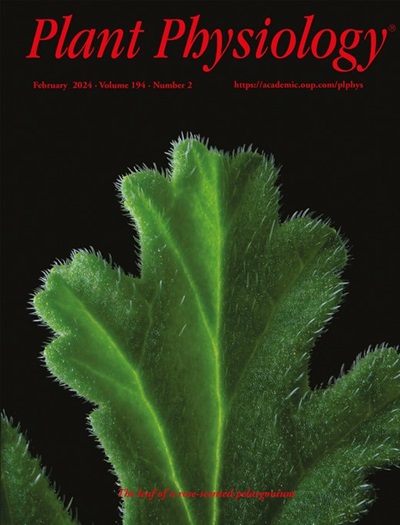The transcription factor FveMYB117a controls leaf morphology by coordinating auxin and cytokinin signals in woodland strawberry
IF 6.5
1区 生物学
Q1 PLANT SCIENCES
引用次数: 0
Abstract
Leaf morphology affects physiological activities and contributes to environment adaptation. The phytohormones auxin and cytokinin both regulate leaf shape, but how they act together to specify leaf complexity is not fully understood. In woodland strawberry (Fragaria vesca), the wild type develops trifoliate leaves, whereas myb117a mutants produce one to five leaflets with fewer serrations. Transcriptome analysis revealed that the auxin biosynthesis gene YUCCA4 (FveYUC4), the cytokinin biosynthesis gene ISOPENTENYL TRANSFERASE2 (FveIPT2), the cytokinin degradation gene CYTOKININ OXIDASE/DEHYDROGENASE1 (FveCKX1), and the transcription factor gene CUP-SHAPED COTYLEDON2 (FveCUC2a) are altered in the myb117a mutant. Accordingly, the myb117a leaves contain lower auxin levels and higher cytokinin levels compared to wild type. Moreover, treatment with the auxin transport inhibitor NPA produced simple leaves with smooth margins, whereas exogenous cytokinin application resulted in a higher percentage of four to five leaflets in myb117a. Several lines of evidence showed that FveMYB117a can directly bind to the promoters of FveYUC4 and FveCUC2a and influence their expression. Both myb117a yuc4 and myb117a cuc2a double mutants had fewer leaflets with greatly reduced or no serrations compared to myb117a, suggesting that these genes function in the same pathway. Overall, our results indicate that FveMYB117a is a transcription factor that coordinates auxin and cytokinin homeostasis in young leaves, thereby contributing to robust leaf morphogenesis in strawberry.转录因子FveMYB117a通过协调生长素和细胞分裂素信号控制林地草莓叶片形态
叶片形态影响植物的生理活动,有助于植物适应环境。植物激素生长素和细胞分裂素都调节叶片形状,但它们如何共同作用以指定叶片复杂性尚不完全清楚。在林地草莓(Fragaria vesca)中,野生型发育三叶状叶片,而myb117a突变体产生1至5个小叶,锯齿较少。转录组分析显示,在myb117a突变体中,生长素生物合成基因YUCCA4 (FveYUC4)、细胞分裂素生物合成基因异opentenyl TRANSFERASE2 (FveIPT2)、细胞分裂素降解基因cytokinin氧化酶/脱氢酶e1 (FveCKX1)和转录因子基因杯形COTYLEDON2 (FveCUC2a)发生了改变。因此,与野生型相比,myb117a叶片的生长素水平较低,细胞分裂素水平较高。此外,使用生长素运输抑制剂NPA处理产生了边缘光滑的单叶,而外源细胞分裂素处理导致myb117a中4到5个小叶的比例更高。多项证据表明,FveMYB117a可以直接结合FveYUC4和FveCUC2a的启动子并影响其表达。与myb117a相比,myb117a yuc4和myb117a cuc2a双突变体的小叶数量更少,且serseries大大减少或没有serseries,这表明这些基因在相同的途径中起作用。综上所述,我们的研究结果表明FveMYB117a是一种协调生长素和细胞分裂素在幼叶中的稳态的转录因子,从而有助于草莓叶片形态发生的稳定。
本文章由计算机程序翻译,如有差异,请以英文原文为准。
求助全文
约1分钟内获得全文
求助全文
来源期刊

Plant Physiology
生物-植物科学
CiteScore
12.20
自引率
5.40%
发文量
535
审稿时长
2.3 months
期刊介绍:
Plant Physiology® is a distinguished and highly respected journal with a rich history dating back to its establishment in 1926. It stands as a leading international publication in the field of plant biology, covering a comprehensive range of topics from the molecular and structural aspects of plant life to systems biology and ecophysiology. Recognized as the most highly cited journal in plant sciences, Plant Physiology® is a testament to its commitment to excellence and the dissemination of groundbreaking research.
As the official publication of the American Society of Plant Biologists, Plant Physiology® upholds rigorous peer-review standards, ensuring that the scientific community receives the highest quality research. The journal releases 12 issues annually, providing a steady stream of new findings and insights to its readership.
 求助内容:
求助内容: 应助结果提醒方式:
应助结果提醒方式:


